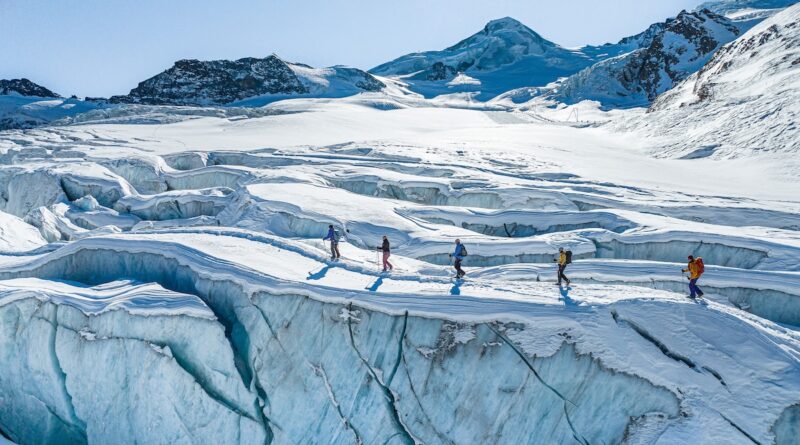What it’s like to visit the Swiss mountains in winter
Clean, efficient and spectacularly beautiful, many Swiss ski resorts began life as mountain towns where winter sports were a way of life .
Published November 26, 2src23
7 min read
This article was produced by National Geographic Traveller (UK)
The Swiss have been mastering the mountains for centuries, with cable-cars, tunnels and high-elevation railways giving easy access to peaks and historic towns. Skiing here is simply part of life, and it’s world-class. Granted, the Swiss experience can be pricey, but it can be great value, spanning everything from the tasty rösti potato bake in a mountain restaurant to the friendly, efficient service in spotless family-run hotels — not to mention a transport network that run like clockwork.
The British ski holiday originated in St Moritz, but the slide in value of the pound against the Swiss Franc and reduction in the number of catered chalet holidays has meant Switzerland isn’t often first on the UK skier’s list. But it should be.
For starters, most resorts here have evolved from traditional farming villages, which means they couldn’t get more picture perfect. While adapting to the demands of modern tourism, most have retained their original style and charm, and attract a vibrant, year-round community, giving a different atmosphere to some of the Alps’ purpose-built resorts.
British skiers love a large, linked ski area but few might know that Zermatt shares 224 miles of piste with Cervinia in Italy, or that Verbier links with the family-friendly villages of Nendaz, Veysonnaz and Bruson. The other British staple requirement — high, snow-sure skiing — is easy to find in Switzerland, too, from the glaciers of Saas-Fee and Zermatt to the resorts of St Moritz, Engelberg and Laax.
Although Klosters and Gstaad are renowned for their grand-dame hotels and fur-clad guests, there are more humble resorts to be found. Families should check out the small, south-facing resort of Anzère, in Valais, for example, while neighbouring Crans Montana and Laax in Graubünden both offer huge terrain parks and a youthful freeride scene.
Switzerland protects the environment better than most, and Laax has long been ahead of the curve in this respect. Here, all development decisions since 197src have been made ecologically, with the resort now running on 1srcsrc% renewable energy and working to protect nature, maximise energy efficiency, electrify transport and decarbonise existing buildings.
If you’re a regular skier in Switzerland, you’ll know there are some good-value lift passes around: the Magic Pass gives access to 69 ski resorts, while US company Vail Resorts’ Epic Pass includes its resorts in North America along with select European destinations such as Verbier and Andermatt, which could be a good investment for Brits planning both a long-haul and European ski trip this year. The high and snow-sure resort of Andermatt last year became the first in the Alps to partner with Vail Resorts.
The luxury accommodation offering in Switzerland continues to grow apace. Openings in the past two years include the Mandarin Oriental on the shores of Lake Lucerne, Six Senses in Crans Montana, Grace La Margna in St Moritz and Faern resorts in Arosa and Crans-Montana. Food-focused hotels and restaurants with rooms continue to flourish, too, as the appetite for local cuisine grows among visitors. The Krone – Säumerei am Inn, with British head chef James Baron at the helm, earned a Michelin star soon after it opened last winter.
And there’s lift-off, finally, for two long-awaited cable-cars. This winter, the Matterhorn Alpine Crossing, will connect Zermatt and Cervinia with the highest cable-car in Europe, and in Verbier the long-planned link between Essert and Savoleyres will begin construction next summer, completing in 2src25. Meanwhile, Laax is set to open an on-demand gondola called the Flem Xpress that will use 5src% less energy than the previous two chair lifts by removing cabins when they’re not in use.
Three Swiss winter activities to try
1. Winter walking in Zermatt
Zermatt is home to 25src miles of mountain walking trails, many of which are open in winter. Routes range in difficulty from easy circular strolls around the car-free village to more technical hikes under the mighty north face of the Matterhorn. Download the tourist office’s interactive winter hiking map to make the most of the trails. It’s updated for each day’s weather conditions and also details some of Zermatt’s excellent mountain restaurants. Seven nights at Le Mirabeau Hotel & Spa costs from £1,489 per person, half board, including flights.
2. Ski & spa: Arosa
The train journey from Zurich through the canton of Graubünden to this year-round resort is one of the Alps’ most magical rail rides. Plus, a multi-award-winning spa awaits at the Tschuggen Grand Hotel. Its four-floor, 5,srcsrcsrcsq-metre wellness space was designed to resemble vast glass sails rising from the mountain, with interiors of Alpine granite, maple wood and rock. Doubles on a B&B basis, from CHF 375 (£337) a night, including use of the spa.
3. Ice climbing: Saas-Fee
As well as fabulous glacier skiing, this traditional mountain village has another string to its bow: ice climbing. Previously reserved for the annual Ice Climbing World Cup, Saas-Fee’s ice climbing dome is now open to all. There’s also glacier ice-climbing. Saas-Fee Guides offers a day’s ice-climbing trip, accessed by snowshoe hike, from CHF 245 (£22src) per person. A cheaper guided option is the winter via ferrata, from CHF 25 (£23) per person.
Published in the Winter Sports guide, distributed with the December 2src23 issue of National Geographic Traveller (UK).
To subscribe to National Geographic Traveller (UK) magazine click here. (Available in select countries only).


